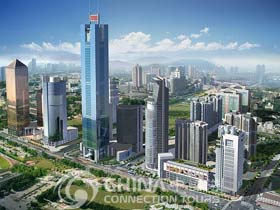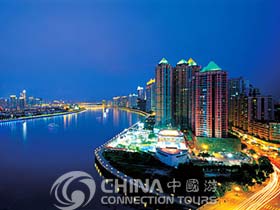
 Guangzhou is the capital city of Guangdong Province in the southern part of China, located 182 kilometers away from Hong Kong; it is China's largest and most prosperous city in the south. Guangzhou is the trade center of south China and hosts annual spring and autumn exports fairs. Due to its convenient location, Guangzhou has international air routes link it to Bangkok, Manila, Singapore, Sidney and Melbourne. Daily flights, trains, ships and hovercraft go between the city and Hong Kong.
Guangzhou is the capital city of Guangdong Province in the southern part of China, located 182 kilometers away from Hong Kong; it is China's largest and most prosperous city in the south. Guangzhou is the trade center of south China and hosts annual spring and autumn exports fairs. Due to its convenient location, Guangzhou has international air routes link it to Bangkok, Manila, Singapore, Sidney and Melbourne. Daily flights, trains, ships and hovercraft go between the city and Hong Kong.
Guangzhou Geographical Features
Guangzhou is located in the southeast of Guangdong Province and in the north of the Pearl River Delta. Crossed by the Tropic of Cancer, it is located between longitude 112°57' to 114°3' east and latitude 22°26' to 23°56' north, bordering on the South China Sea, adjacent to Hong Kong and Macao. It is a regional central city in South China, and China's Southern Gateway to the world.
 The topography is higher in the northeast, lower in the southwest. North and northeast are mountainous area with waters, south is an alluvial plain - the Pearl River Delta. Guangzhou enjoys a subtropical monsoon climate. There is neither intense heat in summer nor severe cold in winter. It enjoys plenty rainfall and evergreen in four seasons. The average temperature is 22.8℃, the average relative humidity is about 68%, and the annual rainfall at the urban area is over 1,600 mm.
The topography is higher in the northeast, lower in the southwest. North and northeast are mountainous area with waters, south is an alluvial plain - the Pearl River Delta. Guangzhou enjoys a subtropical monsoon climate. There is neither intense heat in summer nor severe cold in winter. It enjoys plenty rainfall and evergreen in four seasons. The average temperature is 22.8℃, the average relative humidity is about 68%, and the annual rainfall at the urban area is over 1,600 mm.
Guangzhou is a booming city with a strong economy and fast growth, which benefits the people's livelihood along the way. Compared with Beijing, Shanghai, Tianjin, Chongqing, Xi'an, Wuhan, Shenyang, Harbin and Nanjing, Guangzhou now has the highest per-capita income and living expenditure with the Engel Index dropping below 39.4%, which shows that the Guangzhou residents as a whole are now enjoying an affluent life. Just within the 5 years from 2000-2005, the per capita disposable income of Guangzhou residents increased by 50.7%. Living expenditures are now entering a period of growth and luxury. Evidence of increasing expenditure in housing, cars, education, entertainment, transportation and communication indicates that the people's living standard is on the rise.
Guangzhou is a famous cultural city with a history of more than 2,200 years. As early as the Chou Period, in the 9th century BC, there were exchanges between the Baiyue people of Guangzhou and the people of the Chu State in the middle reaches of Yangtze River. The name "Chu Ting", which was the earliest name of Guangzhou, originated in the 33rd year of Emperor Qin Shihuang (214 BC). Qin unified Lingnan, Nanhai prefecture (the Capital was built at "Panyu") and in the year of 226, in order to strengthen his rule, Sun Quan divided the original Jiaozhou into two parts- Jiaozhou and Guangzhou, name of Guangzhou was established. When the municipal council was set up in 1921, Guangzhou became the city it is today.
Three feudal dynasties, Nanyue, Nanhan and Nanming, chose Guangzhou as their capital. During the Qin (221 B.C. to 206 B.C) and Han (206 B.C. to A.D. 220) Dynasties, Guangzhou was a prosperous city. It was the earliest trade port in China and was the starting point of the "Silk Road of the Sea" beginning with the Han (206 B.C. to A.D. 220) and Tang (A.D. 618 to A.D.907) Dynasties.

